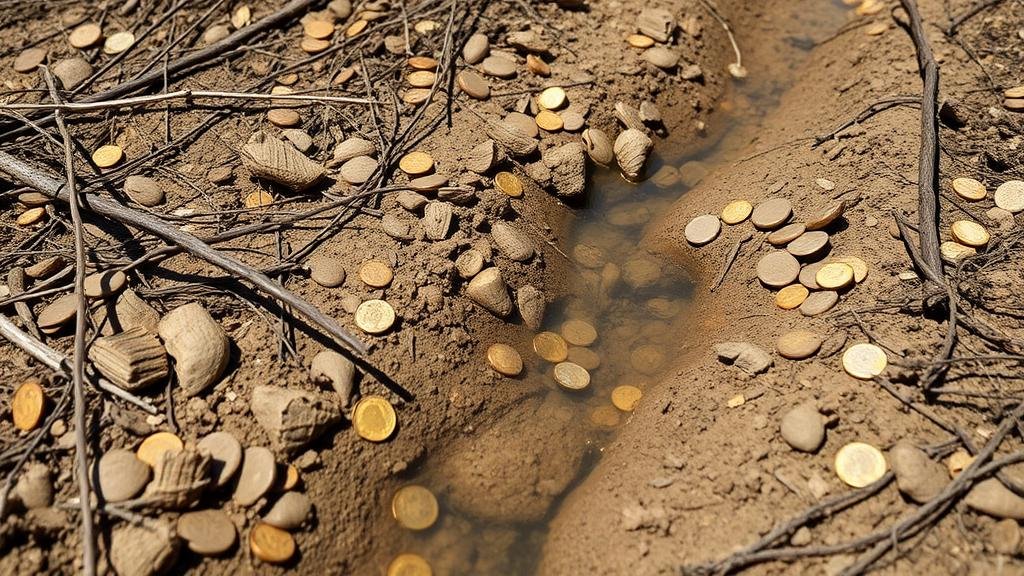Detecting for Coins in Dried-Up Creek Beds and River Channels
Detecting for Coins in Dried-Up Creek Beds and River Channels
Coin detecting in dried-up creek beds and river channels is not only an exciting hobby but can also be a rewarding pursuit for those interested in archaeology, history, and treasure hunting. Rivers and creeks have historically served as vital water supplies and trade routes, making them hotspots for lost coins over the centuries. This article will explore the methods, equipment, and strategies for effectively detecting coins in these unique environments.
The Appeal of Dried-Up Waterways
Dried-up creek beds and river channels present unique opportunities for coin detection. Over time, severe weather events can alter water flow, expose hidden treasures, and reveal new areas for exploration. The appeal lies not only in the potential monetary gain from finding coins but also in the fascinating history each item may represent.
Understanding the Geographical Landscape
To successfully detect coins, it is essential to understand the geography of creek beds and river channels. Various factors contribute to the accumulation of lost items, including:
- Water Flow Patterns: Analyzing historical maps and understanding how water once flowed can lead to lucrative detection areas.
- Depositional Zones: Identify the accumulation zones where sand, silt, and gravel settle, as coins often collect here.
- Human Activity: Areas near historical trading posts, campsites, and community events were often bustling, increasing the likelihood of lost coins.
Essential Equipment for Coin Detection
The right equipment can make a significant difference in your detection success. Essential tools include:
- Metal Detector: Invest in a quality metal detector designed for wet conditions and capable of detecting small objects like coins. Popular brands include Garrett, Minelab, and Fisher.
- Digging Tools: Use trowels or specialized digging tools that allow you to excavate coins without damaging them or the surrounding environment.
- Headphones: Using headphones helps to better identify target signals, especially in areas with background noise, such as near roads or wildlife.
- Waterproof Gear: If detecting near or in water, ensure your gear is waterproof, including the metal detector, to protect your equipment and enhance your searching capabilities.
Techniques for Effective Detection
Employing effective techniques can significantly enhance your chances of finding coins. Consider the following methods:
- Grid Search Method: Methodically cover an area using a systematic pattern, such as a grid, to ensure thoroughness.
- Sweeping Technique: Keep your detector low and sweep across the ground in overlapping arcs, maintaining a consistent speed to detect coins.
- Target Recovery: Carefully dig where you receive signals, and use a pinpointer to assist in precise recovery, minimizing disturbance to the environment.
Historical Context and Its Importance
Understanding the historical context of an area can enhance your findings. Many coins can provide insight into the local history. For example, the discovery of a 19th-century coin may indicate previous trade routes or settlement patterns.
Case studies have shown that individuals detecting in historically rich areas have discovered rare coins, such as Civil War tokens or Spanish reales, which fetch significant value among collectors. Such findings underscore the importance of researching local history before embarking on a detection expedition.
Rules and Regulations
Before detecting in creek beds and river channels, it is crucial to familiarize yourself with local laws and regulations regarding metal detecting. Many areas require permits, and specific regions may be off-limits due to archaeological protections. Always respect land ownership and conservation efforts, ensuring that your activities remain ethical and legal.
- Obtain Permissions: Always seek permission to detect on private land and respect any posted signs.
- Follow Local Laws: Research and adhere to local laws regarding metal detecting, especially in historical or protected sites.
Environmental Considerations
While pursuing coin detection, it is vital to consider the environmental impact. Follow the principle of Leave No Trace by:
- Avoiding Damage: Be mindful of the ecosystems in creek beds, and avoid trampling sensitive vegetation.
- Minimizing Disturbance: Fill any holes you dig and pack out trash or debris to maintain the natural environment.
Actionable Takeaways
Detecting for coins in dried-up creek beds and river channels can lead to remarkable discoveries and offers a fascinating glimpse into history. Here are some actionable takeaways to enhance your experience:
- Conduct thorough research on the area’s history before starting to enhance your chances of finding valuable objects.
- Invest in quality metal detecting equipment and practice effective searching techniques to optimize your results.
- Always comply with local laws and environmental regulations to ensure your activities are responsible and sustainable.
To wrap up, with preparation, knowledge, and respect for the environment, detecting coins in dried-up creek beds and river channels can be a rewarding venture. Each outing not only has the potential for treasure but also enriches our understanding of the past.



